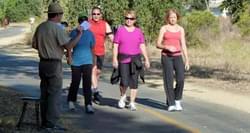




Measuring the benefits and economic development of trails.

If you aren’t counting and surveying trail users, you may be missing an opportunity to better fund your program and help the community understand the value of your trail system or interconnected network of trails. The National Bicycle and Pedestrian Documentation Project is a great place to learn more about counting methods and data collection equipment.
San Jose, California has conducted an annual trail count and survey of trail users since 2007. Since that first count, San Jose has initiated a trail closure policy that preserves access to the greatest extent possible and has increased awareness about the value of trails for both recreation and commuting. The regularly counting process also documents that trail usage has increased year after year – which helps to reinforce that trail development is a good investment.
The 2011 count documents a 5.7% in increase in trail use along the Guadalupe River Trail at a station that has been in use since the first year. Trail Count has also made San Jose more competitive for grant funding, helped improve the planning of future trails, and has supported inclusion of trails in the City’s General Plan update as a transportation element.
What does “economic benefits” really mean in the context of trails, tourism, and communities? A trail can have an economic impact on the community in several ways. Indirect impacts such as increased property values for residences and businesses located near the trail, as well as health benefits to users of the trail. However, the economic value is determined to a large extent on the number of trail users, how many of these come from outside the immediate vicinity of the trail, how much they spend on their visits to the trail, etc. This is why the extent of traffic on the trail over the course of a year is so important to determine.
Another way that we all benefit from trail facilities is increased public health. Studies are beginning to look at the link between trail use and health benefits.
American Trails Resource Library hosts many articles on the benefits of trails that are available online.
posted May 24, 2021
Are there any graduate programs that are focused on trail planning, development, and design?
FAQ: Apps for Trail Management and Volunteers
posted May 19, 2021
Information on apps that can be used for trail management that would be suitable for volunteer-type organizations.
FAQ: What is the definition of a trail?
posted Jan 14, 2021
Defining a trail corridor in law, policy, and planning.
1,737 views • posted 07/17/2018